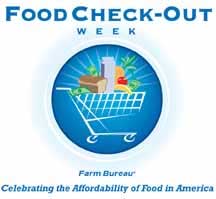Escambia Farm Bureau Marks Food Check-Out Week With Food Drive
February 7, 2008
The Escambia County Farm Bureau is celebrating this week as Food Check-Out Week, the week into the new year where the average household will have earned enough to pay for its food for a year.
The Escambia County Farm Bureau Women’s Committee is commemorating this event by setting up food donation boxes at Piggly Wiggly in Davisville and at the Farm Bureau offices on Highway 97 in Molino and at the Davisville Piggly Wiggly. All food collected will be donated to the Manna Food Bank.
The average cost of food in America remains affordable overall. According to the most recent information from the Agriculture Department’s (USDA’s) Economic Research Service, American families and individuals spend, on average, less than 10 percent of their disposable personal income for food.
Applying that statistic to the calendar year means the average household will have earned enough disposable income — that portion of income available for spending or saving — to pay for its annual food supply in about 37 days or five weeks, according to the Escambia County Farm Bureau.
 In recognition of this, Escambia County Farm Bureau is celebrating Feb. 3-9, 2008, as Food Check-Out Week.
In recognition of this, Escambia County Farm Bureau is celebrating Feb. 3-9, 2008, as Food Check-Out Week.
Not only is America’s food supply among the world’s safest, it is the most affordable, said Ray Crawford, Farm Bureau Field Staff Director. “The abundant, affordable and safe domestic food supply produced by America’s farmers and ranchers is responsible, at least in part, for our nation’s increasing standard of living.”
“Americans work longer each year to pay for their housing, federal taxes and medical care, compared to food,” Crawford said.
According to the Tax Foundation, Americans work an average of 52 days each year to pay for health and medical care, 62 days to pay for housing/household operation and 77 days to pay federal taxes.
Crawford said the food we enjoy as consumers is a product of our successful food production and distribution system, as well as America’s farmers and ranchers continuing to have access to effective and affordable crop protection tools.
This week should hold meaning for most Americans, he said. “We remain concerned that some Americans cannot afford to buy the food they need, but we are proud of the role Florida farmers play in producing the most affordable food in the world.”
The percent of disposable personal income spent for food has declined over the last 35 years. In 1970, it took Americans 14 more days to earn enough income to pay for their food supply for the year. According to USDA, food is more affordable today due to a widening gap between growth in per-capita incomes and the amount of money spent for food.
This overall decrease is made more notable by trends indicating Americans are buying more expensive convenience foods, as well as more food away from home.
USDA’s latest statistic, compiled for 2006, includes food and non-alcoholic beverages consumed at home and away from home. This includes food purchases at grocery stores and other retail outlets, including food purchases with food stamps and vouchers for the Women, Infants and Children’s (WIC) program. The statistic also includes away-from-home meals and snacks purchased by families and individuals, as well as food furnished to employees.
Food Check-Out Day tracks the amount of income needed by Americans to purchase food on an annual basis, Crawford said. “There have been some slight fluctuations over the past few years, but food prices have remained relatively stable over time.”



Comments